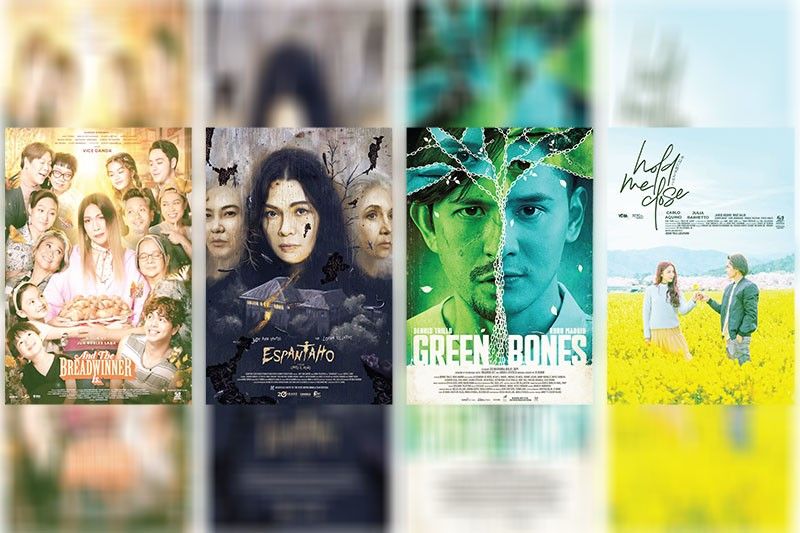MMFF at 50: What makes each film worth watching?

That time of the year has come when the Metro Manila Film Festival (MMFF), which is having its golden edition, presents a collection of films that are in stark contrast in terms of narrative and theme. There are two or even more, however, that may belong to the same genre classification.
Film enthusiasts and the public have until the first week of next year, 2025, to watch the 10 entries — “And the Breadwinner Is…,” “Espantaho,” “Green Bones,” “Hold Me Close,” “Isang Himala,” “My Future You,” “Strange Frequencies: Taiwan Killer Hospital,” “The Kingdom,” “Topakk” and “Uninvited — and see for themselves how each film unfolds.
Given their titles and trailers, I wonder what about each official entry that would pique one’s attention and interest.
And here are my two cents:
Although we’re familiar with the Pinoy diaspora and migration to different parts of the world for greener pastures, I’m excited to know the “hugot” of the main character Bambi Salvador, an Overseas Filipino Worker (OFW) in “And the Breadwinner Is.” The character’s “hugot” may encompass an emotional romantic heartbreak and an emotional filial heartbreak, with the nagging question: Which of the two is more heartbreaking?
In love life and family life, one makes sacrifices to make the relationship work and hopes that they are reciprocated and valued.
As one follows the familiar and unique story of Bambi, one may see what makes a breadwinner a winner. Is it the material gain, the family devotion, or something else?

From a family story, told in comedy and melodrama, “Espantaho” revolves around two families fighting over legal rights and the ownership of the house, with the pasiyam or nine-days prayer for the demise of a patriarch.
It can be deemed the conflict, but there’s a scarier conflict members of the house must deal with. The revelation of it and the root cause are what may make one get intrigued.
What or who should the characters be afraid of is a valid question: The people who antagonize them or the entity that lurks in the house or could be “endemic” to the community?
Common knowledge tells us that “espantaho” or scarecrow is used to ward off animals like birds that steal fruits or destroy crops. That’s why it is part of an idyllic landscape.
In the film, is the scarecrow a cultural material invention to drive away a spirit that shakes anyone’s peaceful existence or to signal the arrival of an “uninvited” or “expected” visitor?
Speaking of the latter, Eva Candelaria, the female figure in “Uninvited, goes to a gathering and some character is curious to know what motivates and empowers her to gatecrash and to be in it.
Audiences will also be on the same page and look forward to what “knowledge” or “truth” she is privy to that will shock everyone present.
Given the character’s surname, it seems Eva will shed light on what has been going on in the family or a family member.
What’s interesting is how all of her past memories and present thoughts will be encapsulated in a day to display to all and sundry her surprised arrival or comeback.
She may be in a quandary at certain points, but one hopes that she holds on to a plan she has hatched.
A group of amateur celebrity ghost hunters has a clear intention to document supernatural activities and manifestations in “Strange Frequencies: Taiwan Killer Hospital.” What could get one’s imagination here is the discovery of an entity or presence that also resides in one’s mind.
The question is: How much of it is real or reel? given some possibility for some characters to manipulate what’s caught on cam. The existence of “strange frequencies” is true and valid, but how much of it could be a projection of what the characters are thinking?
It may be challenging at first, but the experience, I think, is unforgettable on how the viewers will accept the “play” that the actors are portraying themselves as characters because the film is in the meta genre, with some aspects of it that tell the audiences that what they’re watching is still part of a filmic narrative, a product of someone’s vision.
Interestingly also to consider is how the setting can be viewed as another character that may support or prevent the characters from fulfilling their goal to present a show that will build and solidify their fame.
From the supernatural and unknown realm, one enters an imagined Philippines, or “world,” away from the Western influences and powers in “The Kingdom.”
With that, it will give viewers a pre-colonial Philippines feel, in which every village is with a patriarchal leader, the lakan, and a clear social stratification.
The current ruler needs to choose a rightful successor. It seems that gender is not a consideration, in which in pre-colonial times, a historical account shares that male and female children were treated equally in terms of work training and inheritance.
Even if male presence couldn’t be denied, women enjoyed an egalitarian life.
That’s something one can wish to see in the movie, especially when a female character is offered to rule and take the reins.
There’s also the familiar theme of the rich get richer while the poor get poorer that adds a relevant social and political layer to it.
One may also wonder how those in the social periphery will question the status quo or tip the balance. A power struggle is in the offing and it might usher in a new chapter in a kingdom that thrives under a monarchial rule.
The film will enrich in a way one’s sense of understanding about the Philippines.
Another place viewers will get to know is the small town named Cupang, which has become a witness to the change in Elsa, a woman who has seen an apparition of the Virgin Mary in “Isang Himala.” Filipinos are familiar with the narrative that was first told in film and then on stage and this time, in film again as a musical piece.
What one can look forward to are the songs that will leave a lasting impression on them and the film theme about faith and the “miracles” it brings to the faithful.
Lady Luck or destiny seems to play a role in how a young man and a woman named Lex and Karen meet through a dating app who live in different timelines in “My Future You.” How it becomes possible and plausible is something everybody wants to know.
Along that line is the revelation of their emotional state and personal stories that connect them and possibly create such a rare opportunity and chance for them to have found each other.
What’s interesting here are the repercussions that come with getting to know a person from another time and space, and the “truths” each character must accept in the process. Is there another chance for them to finally meet and stand in the same physical space?
Those are the questions that need to be answered.
Domingo Zamora, on the other hand, inhabits a space that gives him time to reflect on a past life, including wrong doings, which is a penal colony without walls, to face his future in “Green Bones.” The person deprived of liberty, who has shown exemplary good character, will finally be free.
A young prison officer is about to do everything to thwart it.
Viewers have to make sense of who is the real protagonist or antagonist in the narrative and the link why their paths need to cross.
From there, one can adjudge the “character” or “goodness” of the characters, and may connect to the story of “green bones.” Who has the best intentions or is telling the truth?
There are ways to know and tell the “truth.” A woman named Lynlyn in “Hold Me Close” has the ability to know if a person will make her happy or not by touching. It may serve as a shield to spare herself from experiencing pain and a tool in finding happiness.
As viewers embrace the story premise, perhaps they’re confronted with the initial question: “How has she acquired it?,” and with another one that goes: “Does she consider it a boon or bane?”
They would also like to know how limiting such a gift is to her because sometimes the best way to enjoy life moments is with spontaneity and not knowing what comes next or after.
From physical realms, it seems that “Topakk” brings viewers to the mental world of someone who is “triggered” by feeling of loneliness, loss of loved ones, or a traumatic lingering first-hand experience. Viewers should look for clues within the narrative that will guide them to know where the male lead character is coming from and help them navigate his story.
He is described as a soldier who meets a woman who needs his immediate help.
Perhaps part of the narrative is to see his daily struggles at work and ways to make his plight bearable.
For this edition of MMFF, these are some of the thoughts I bring as I enter the cinema and watch the film entries. Let’s support the Philippine film industry.
Well, one thing is for sure: Audiences are presented with a diverse and engaging collection of narratives to watch and enjoy.
- Latest
- Trending



























 Exclusive
Exclusive





